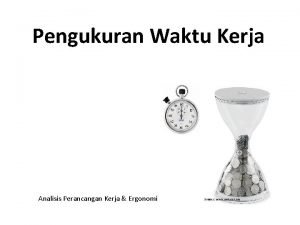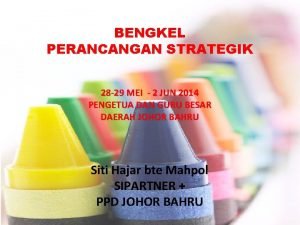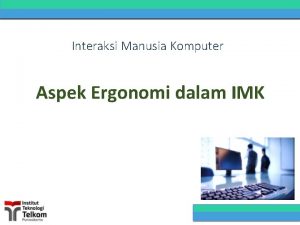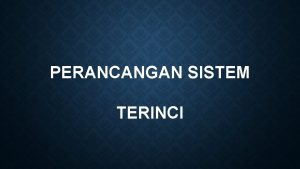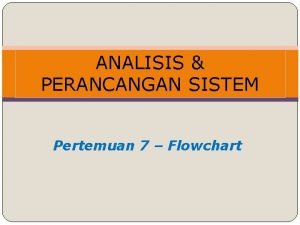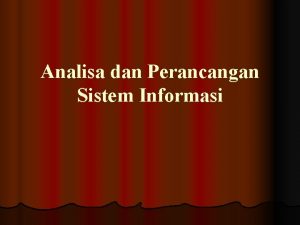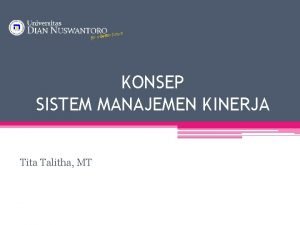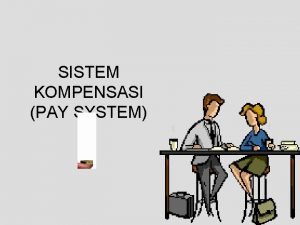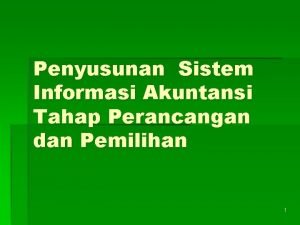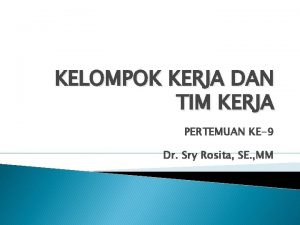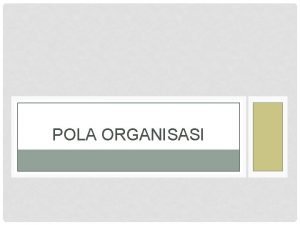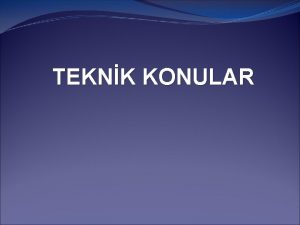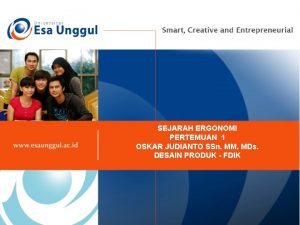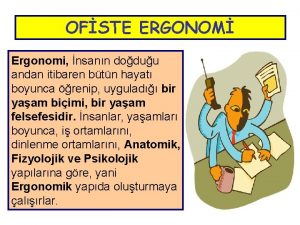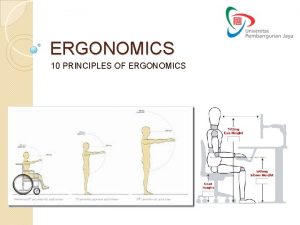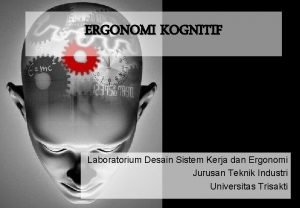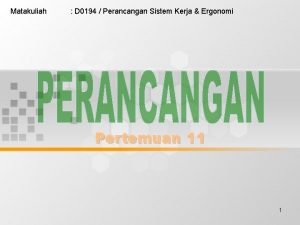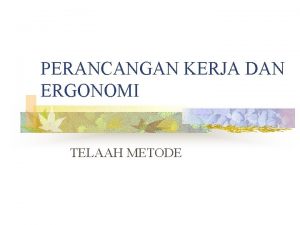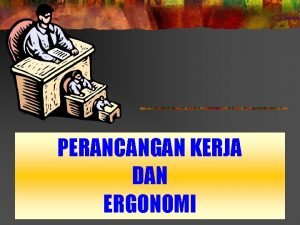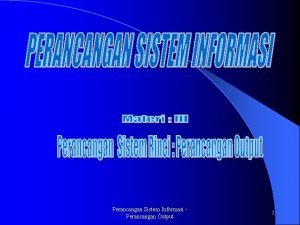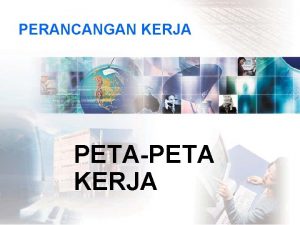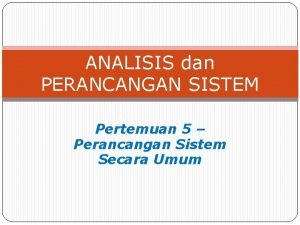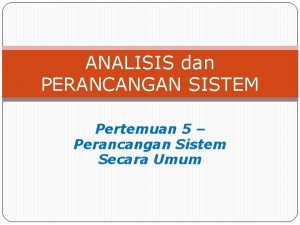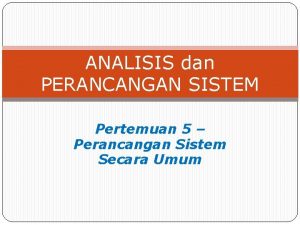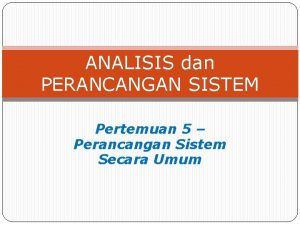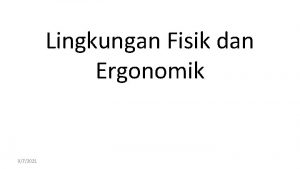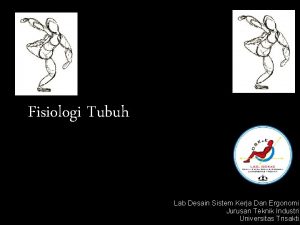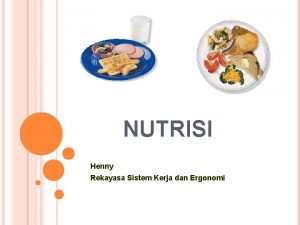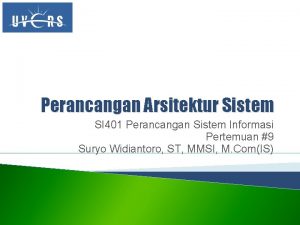TI 2111 Perancangan Sistem Kerja dan Ergonomi Handout






















- Slides: 22

TI 2111 – Perancangan Sistem Kerja dan Ergonomi Handout Mata Kuliah Lab. Perancangan Sistem Kerja & Ergonomi Institut Teknologi Bandung 2006 TI 2111 Work System Design and Ergonomics

TI 2111 – Syllabus TI 2111 Work System Design and Ergonomics

TI 2111 – Course Description • Survey of Industrial Engineering methods for measuring, evaluating, and improving performance of work systems in organizations. • Introduction to Ergonomics with an emphasis on human capabilities and limitations. • Discussion of application of Industrial Engineering and Ergonomics design principles to redesign workstations, work tasks, and work environments. TI 2111 Work System Design and Ergonomics

TI 2111 – Course Objectives • Describe the role of Work measurement & Ergonomics in the workplace • Conduct a methods engineering study of a particular job, including methods analysis, time studies, and work sampling studies. • Apply industrial engineering and ergonomics / human factors design principles to the analysis and redesign of an existing work station, work task, piece of equipment, work environment, etc. TI 2111 Work System Design and Ergonomics

Course Texts n Niebel B. and Freisvalds A. (2003). Methods, Standards, and Work Design, 11 th ed. , Mc. Graw-Hill, Boston n Wickens C. et al. , (2004). An Introduction to Human Factors Engineering, 2 nd ed. , Pearson Prentice Hall, London TI 2111 Work System Design and Ergonomics

Course Topics n n n Introduction: Definitions, historic review, motivation Work System Design q Definitions, objectives and performance measures q Time study: methods & equipment q Performance Rating and Allowances q Standard Times q Predetermined Time Systems q Work Sampling Ergonomics q Introduction q Visual, Auditory, Cognition q Display and Control q Biomechanics, Physiology TI 2111 Work System Design and Ergonomics

Grading (subject to change) Course Requirement Percentage of grade Examinations (2) 60% Quizzes 10% Homework (2) 15% In-class activities 15% Class participation Bonus TI 2111 Work System Design and Ergonomics

Miscl. n n n Regular class attendance and participation This class is designed to allow students to apply the concepts, no one correct solution All written assignments will be graded on the quality of the work. It is expected that each student will provide well-written and defended solutions to the problems for this class. Only legible handwriting will be graded. If you have a dispute about a grade for any assignment or examination, provide the instructor with a written explanation no later than 1 week after the work was returned to you. I do make mistakes, so please don’t hesitate to bring them to my attention. I will strive to make this an exciting class. I welcome your suggestions for improving the course at any time. TI 2111 Work System Design and Ergonomics

Do’s and Don’t n n n Do read the material before class. . . Do your homework … Ask questions … Don’t wait till the last minute … Don’t even think about copying others … TI 2111 Work System Design and Ergonomics

Tentative Schedule (Subject to Change) Week Topic Reading Assignments 1 Course introduction, History, & Motivation 1. 1 2 Problem solving and operation analysis tools (7 tools, 5 W-1 H, 5 Why, charts, etc. ) Motion study & Principles of motion economy 1. 2, 1. 3 1. 4 3 Kaizen, Poka Yoke, SMED Time study: Concept & Introduction 1. 9 4 Time study: Cycle time, rating factors, and allowance 1. 10, 1. 11 5 Time study: Standard time Predetermined time systems 1. 12 1. 13 6 Work sampling 1. 14 7 Wage payment Midterm exam 1. 17 8 Intro to Human Factors Engineering Visual sensory system 2. 1 2. 4 9 Auditory system Cognition system 2. 5 2. 6 10 Display Control 2. 8 2. 9 11 Engineering anthropometry Biomechanics of work 2. 10 2. 11 12 Work Physiology Stress and Workload 2. 12 2. 13 13 Safety, accidents, and human error HCI and Automation 2. 14 2. 15 & 2. 16 14 Selection and Training Guest lecture 2. 18 TI 2111 Work System Design and Ergonomics

1. Introduction TI 2111 Work System Design and Ergonomics

Industrial Engineering ? n 1948: American Institute of Industrial Engineering (AIIE) (www. iienet. org) …is concerned with the design, improvement, and installation of integrated systems of people, material, information, equipment, and energy. It draws upon specialized knowledge and skills in the mathematical, physical, and social sciences together with the principles and methods of engineering analysis and design to specify, predict, and evaluate the results to be obtained from such systems. n . . . is concerned with the analysis, design, installation, control, evaluation, and improvement of socio-technical systems in a manner that protects the integrity and health of human, social, and natural ecologies. A socio-technical system can be viewed as any organization in which people, materials, information, equipment, procedures interact in an integrated fashion TI 2111 Work System Design and Ergonomics

Modern industrial organization - - Increasing competition (increased number of competitors) Stiffer requirements for international competitiveness (i. e. ISO standards) High sophistication in quality of products demanded by customers … Productivity Quality Efficiency Effectiveness Safety Comfort TI 2111 Work System Design and Ergonomics

“We are in a new economic age. We can no longer live with commonly accepted levels of delays, mistakes, defective materials and defective workmanship. ” W. Edward Deming, 1968 TI 2111 Work System Design and Ergonomics

Performance measures TI 2111 Work System Design and Ergonomics

Ways to improve performance of a work system: n n n Improved layout, workflow, and material handling Training Work simplification Job/tools redesign Improved work environment Workers selection Methods Standards Work design Ergonomics TI 2111 Work System Design and Ergonomics

Work System Design (& Ergonomics) – “PSK&E” n Purpose : To increase productivity in industry, while maintaining worker health and safety thru: q q n Work Measurement Methods Engineering Continuous and repetitive process q Work measurement (e. g. Time study) n q A process for measuring … Work Methods n Systematic procedure for analyzing a given task TI 2111 Work System Design and Ergonomics

TTCK → PSK&E (Sutalaksana, 1979) TI 2111 Work System Design and Ergonomics

“PSK&E” - Objectives n n n Minimize times (Fig. 1. 2) Improve quality and reliability Minimize direct and indirect material cost Maximize the safety and well being of the workers Increase job interest and satisfaction for the workers TI 2111 Work System Design and Ergonomics

PSK&E - Applications n Design and improvement of work methods n Establish a standard work methods and standard time n Training & Workers selection n Lay-out design n Economic analysis, costing, task evaluation n Reward & workers motivation n Production planning and control n Product design n … TI 2111 Work System Design and Ergonomics

Historical Development n The origin of time study q q q Frederic W. Taylor Frank Lillian Gilbreth Henry L. Gantt Henry Ford Elton Mayo TI 2111 Work System Design and Ergonomics

Frederic W. Taylor (1856 -1915) n Founder of the ‘Scientific Management’ term n Emphasized on: q q q n Increasing throughput Reducing manufacturing costs As a result, increasing workers’ salaries Tools (how to do the above): q q Divide the task into small elements Separate the non-required from the required elements Setting standards: time, quality, methods. Specialization: training for a specific job TI 2111 Work System Design and Ergonomics
 Jus 2111
Jus 2111 Mpep 2111
Mpep 2111 Alat pengukur waktu
Alat pengukur waktu 9 bidang skksm
9 bidang skksm Aspek ergonomi dalam interaksi manusia dan komputer
Aspek ergonomi dalam interaksi manusia dan komputer Jelaskan istilah ergonomi imk
Jelaskan istilah ergonomi imk Perancangan sistem terinci
Perancangan sistem terinci Flowchart perancangan sistem
Flowchart perancangan sistem Materi perancangan sistem informasi
Materi perancangan sistem informasi Tahap tahap perancangan sistem manajemen kinerja
Tahap tahap perancangan sistem manajemen kinerja Perancangan sistem terinci
Perancangan sistem terinci Perancangan sistem kompensasi
Perancangan sistem kompensasi Tahap perancangan sistem
Tahap perancangan sistem Contoh tim kerja dan kelompok kerja
Contoh tim kerja dan kelompok kerja Pengertian pola organisasi
Pengertian pola organisasi Nota frasa nama
Nota frasa nama Ergonomi konuları
Ergonomi konuları Sejarah ergonomi
Sejarah ergonomi Ergonomi konuları
Ergonomi konuları Types of ergonomics
Types of ergonomics Kognitif ergonomi
Kognitif ergonomi Ergonomi kognitif adalah
Ergonomi kognitif adalah Konsep keseimbangan ergonomi
Konsep keseimbangan ergonomi


